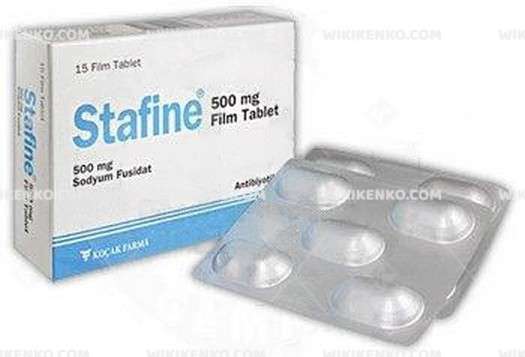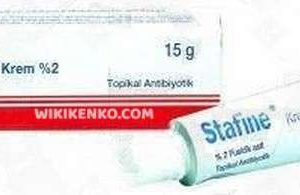Stafine Film Tablet
In the realm of pharmaceutical solutions, “Stafine Film Tablet” stands as a significant player, offering a 500 mg dose of antibiotic prowess. This article provides an extensive overview, covering its composition, indications, precautions, potential side effects, dosage guidelines, and more.
| Dosage form | |
|---|---|
| Pack size | |
| Potency | 500 Mg |
| Manufacturer | |
| Origin | |
| Generic Name (Ingredient) | 500 Mg Sodium Fusidate |
Assuming your emergency circumstances for this product, visit Urgent Quotation page. Besides, for any pharmaceutical questions, please ask us in the comments section.
Description
Stafine Film Tablet
“Stafine” emerges as a crucial medication, available in the form of a 500 mg film tablet. At its heart lies sodium fusidate, a potent antibiotic. This oral medication is designed to combat a spectrum of infections, making it a valuable addition to the medical arsenal.
| Key Information | Details |
|---|---|
| Active Ingredient | Sodium Fusidate (500 mg) |
| Form | Film Tablet |
| Method of Administration | Oral |
Ingredients
The efficacy of a medication often hinges on the blend of ingredients within. In the case of “Stafine Film Tablet,” the following constituents play vital roles:
Active Ingredient
- Sodium Fusidate (500 mg): The cornerstone of this medication, sodium fusidate, takes the lead in tackling a multitude of infections.
Excipients
- Microcrystalline Cellulose
- Crospovidone
- Lactose Anhydrous (sourced from cattle)
- Magnesium Stearate
- Colloidal Anhydrous Silica
- Talc
- Hypromellose E15
- Titanium Dioxide
- Polyethylene Glycol 6000
- Polyethylene Glycol 400
Indications
“Stafine Film Tablet” is a versatile warrior in the realm of infections. It takes aim at an array of conditions, including:
- Skin and Wound Infections
- Blood Infections (e.g., Septicemia)
- Infections in Bone and Heart Tissue
- Lung Infections, such as Pneumonia
- Infections Linked to Cystic Fibrosis
Precautionary
Before embarking on a course of “Stafine Film Tablet,” specific precautions must be heeded:
- Hypersensitivity: If there is any known hypersensitivity to the active ingredient or any of the excipients, usage of this medication should be avoided.
- Caution in Specific Scenarios: “Stafine” should be administered with care in the following situations:
- In cases of liver disorders, liver diseases, or occurrences of jaundice.
- When statins, employed for high cholesterol management, are part of the treatment regimen.
- If there are complications related to the bile duct, such as gallstones.
- When using HIV-protease inhibitors, integral to HIV virus treatment.
Regular blood tests may be necessary if concurrent administration of other medications affecting the liver is planned while taking “Stafine Film Tablet.”
Side Effects
As with any medication, “Stafine” can potentially introduce side effects into the equation. The most frequently reported side effect related to treatment is mild stinging or irritation. However, it’s essential to be aware of more severe reactions, including Stevens-Johnson syndrome (SJS), toxic epidermal necrolysis (TEN), and drug reaction with eosinophilia and systemic symptoms (DRESS), which have been associated with the use of sodium fusidate tablets.
Dosage and Administration
To leverage the full potential of “Stafine,” it’s essential to comprehend the proper dosage and administration guidelines:
- Stafine Pomad %2 should be applied to lesions two or three times a day, typically for a duration of seven days. Sodium fusidate is notably absorbable through the gastrointestinal system. It attains peak plasma concentrations approximately two hours post-ingestion and permeates various body fluids and tissues efficiently.
- Around half of the absorbed component resides in peripheral areas, while the remaining half lodges within cells. Sodium fusidate effortlessly navigates infected bone, synovial fluid, hepatobiliary secretion, bronchial secretion, mucosal tissues, cerebral tissues, abscesses, and all soft tissues. A substantial portion of sodium fusidate exits through bile. Approximately 2% is eliminated unchanged in feces, with the remainder excreted in urine.
Storage
For the integrity of “Stafine Antibiotic,” proper storage is crucial. The medication should be safeguarded at room temperatures below 25°C, ensuring it remains beyond the reach of children.
In Conclusion
“Stafine Film Tablet” is a formidable antibiotic, proficient in tackling a diverse array of infections. However, as with any pharmaceutical solution, its usage should be guided by healthcare professionals. Always adhere to their instructions diligently, and never hesitate to consult your doctor or pharmacist if additional questions regarding this medication arise.
In the quest for health and wellness, knowledge is your greatest ally.
Use the form below to report an error
Please answer the questions as thoroughly and accurately as possible. Your answers will help us better understand what kind of mistakes happen, why and where they happen, and in the end the purpose is to build a better archive to guide researchers and professionals around the world.
The information on this page is not intended to be a substitute for professional medical advice, diagnosis, or treatment. always seek the advice for your physician or another qualified health provider with any questions you may have regarding a medical condition. Always remember to
- Ask your own doctor for medical advice.
- Names, brands, and dosage may differ between countries.
- When not feeling well, or experiencing side effects always contact your own doctor.
Cyberchondria
The truth is that when we’re sick, or worried about getting sick, the internet won’t help.
According to Wikipedia, cyberchondria is a mental disorder consisting in the desire to independently make a diagnosis based on the symptoms of diseases described on Internet sites.
Why you can't look for symptoms on the Internet
If diagnoses could be made simply from a textbook or an article on a website, we would all be doctors and treat ourselves. Nothing can replace the experience and knowledge of specially trained people. As in any field, in medicine there are unscrupulous specialists, differences of opinion, inaccurate diagnoses and incorrect test results.







Reviews
There are no reviews yet.